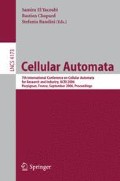Abstract
Generation of large primitive polynomial over a Galois field has been a topic of intense research over the years. The problem of finding a primitive polynomial over a Galois field of a large degree is computationaly expensive and there is no deterministic algorithm for the same. In this paper we present an new recursive algorithm based on cellular automata for generation of very large primitive polynomial over finite fields. The motivation for cellular automata based construction comes into play as it has an excellent regular structure and efficient hardware representation. At the end we give an application of this new construction in a RS-encoded MPSK Modulation in Rayleigh fading channel. But the general construction given here can be extended to any area like cryptography, coding theory etc. having application of sufficiently large Galois field.
Access this chapter
Tax calculation will be finalised at checkout
Purchases are for personal use only
Preview
Unable to display preview. Download preview PDF.
References
Lidl, R., Niederreiter, H.: Introduction to finite fields and their applications. Cambridge University Press, Cambridge (1986)
Sanchez, R., Grau, R., Morgado, E.R.: A new dna sequence vector space on a genetic code galois field. MATCH Commun. Math. Comput. Chem. 54, 3–28 (2005)
Cattell, K., Muzio, J.C.: Analysis of one-dimensional linear hybrid cellular automata over gf(q). IEEE Transactions on Computers 45, 782–792 (1996)
Sun, X., Kontopidi, E., Serra, M., Muzio, J.C.: The concatenation and partitioning of linear finite state machines. Int. J. Electronics 78, 809–839 (1995)
Wolfram, S.: Statistical Mechanics of Cellular Automata. Rev. Mod. Phys 55, 601–644 (1983)
Chaudhuri, P.P., RoyChowdhury, D., Nandi, S., Chattopadhyay, S.: Additive Cellular Automata Theory and its Application, vol. 1. IEEE Computer Society Press, Los Alamitos (1997)
Fujiwara, E., Hamada, M.: Single b-bit byte error correcting and double bit error detecting codes for high-speed memory systems. In: Proceedings International Symposium on Fault-Tolerant Computing (FTCS), pp. 494–501. IEEE Computer Society Press, Los Alamitos (1992)
Lipschutz, S.: Linear algebra, pp. 155–202. Mcgraw-Hill, New York (1968)
Stone, H.S.: Discrete Mathematical Structures and Their Applications, p. 307. Science Research Associates, New York (1973)
Paar, C.: Efficient VLSI Architecture for Bit-Parallel Computation in Galois Fields. Institute for Experimental Mathematics, University of Essen, Germany (1994)
Jamalipur, A.: The Wireless mobile Internet Architectures,Protocols and Services. John Wiley & Sons, The Atrium, West Sussex, England (2003)
Rao, T., Fujiara, E.: Error-Control Coding for Computer Systems. Prentice-Hall, Englewood Cliffs (1989)
Zhang, L., Cao, Z., Gao, C.: Application of RS-Coded Modulation Scenarios to Compressed Image Communication in Multi Fading Channel. In: 52nd IEEE Vehicular Technology Conference, vol. 3, pp. 1198–1203 (2000)
Peterson, W.W., Weldon Jr., E.J.: Error-correcting codes, 2nd edn. MIT Press, Cambridge (1971)
Jamali, S.H., Le-Ngoc, T.: Coded Modulation Techniques for Fading Channels. Kluwer Academic Publishers, Boston (1994)
Author information
Authors and Affiliations
Editor information
Editors and Affiliations
Rights and permissions
Copyright information
© 2006 Springer-Verlag Berlin Heidelberg
About this paper
Cite this paper
Bhattacharya, D., Mukhopadhyay, D., RoyChowdhury, D. (2006). A Cellular Automata Based Approach for Generation of Large Primitive Polynomial and Its Application to RS-Coded MPSK Modulation. In: El Yacoubi, S., Chopard, B., Bandini, S. (eds) Cellular Automata. ACRI 2006. Lecture Notes in Computer Science, vol 4173. Springer, Berlin, Heidelberg. https://doi.org/10.1007/11861201_25
Download citation
DOI: https://doi.org/10.1007/11861201_25
Publisher Name: Springer, Berlin, Heidelberg
Print ISBN: 978-3-540-40929-8
Online ISBN: 978-3-540-40932-8
eBook Packages: Computer ScienceComputer Science (R0)

